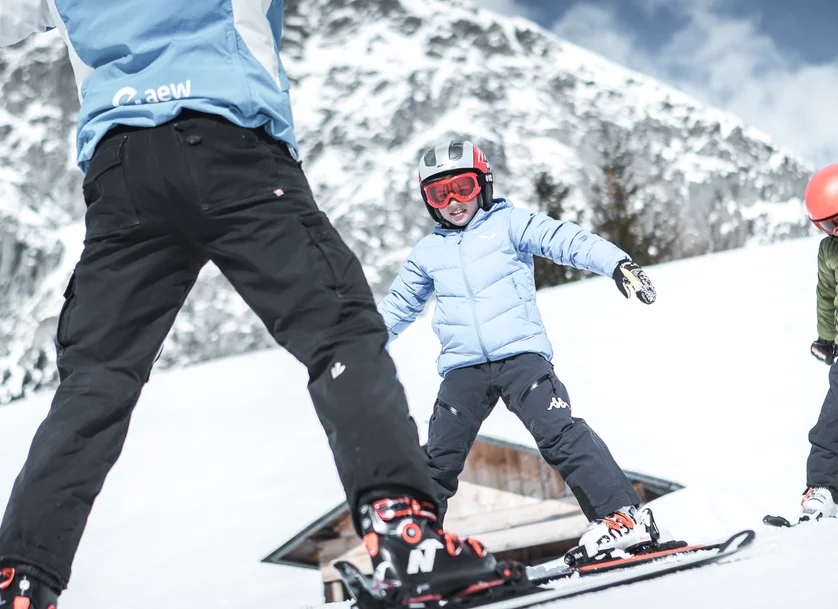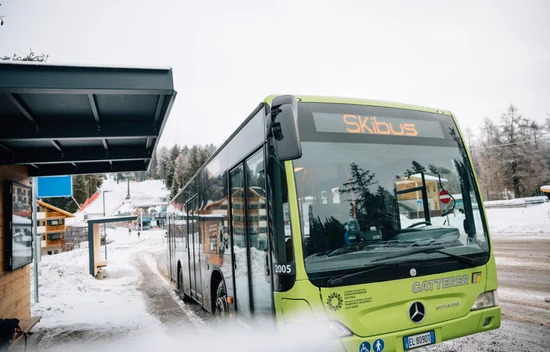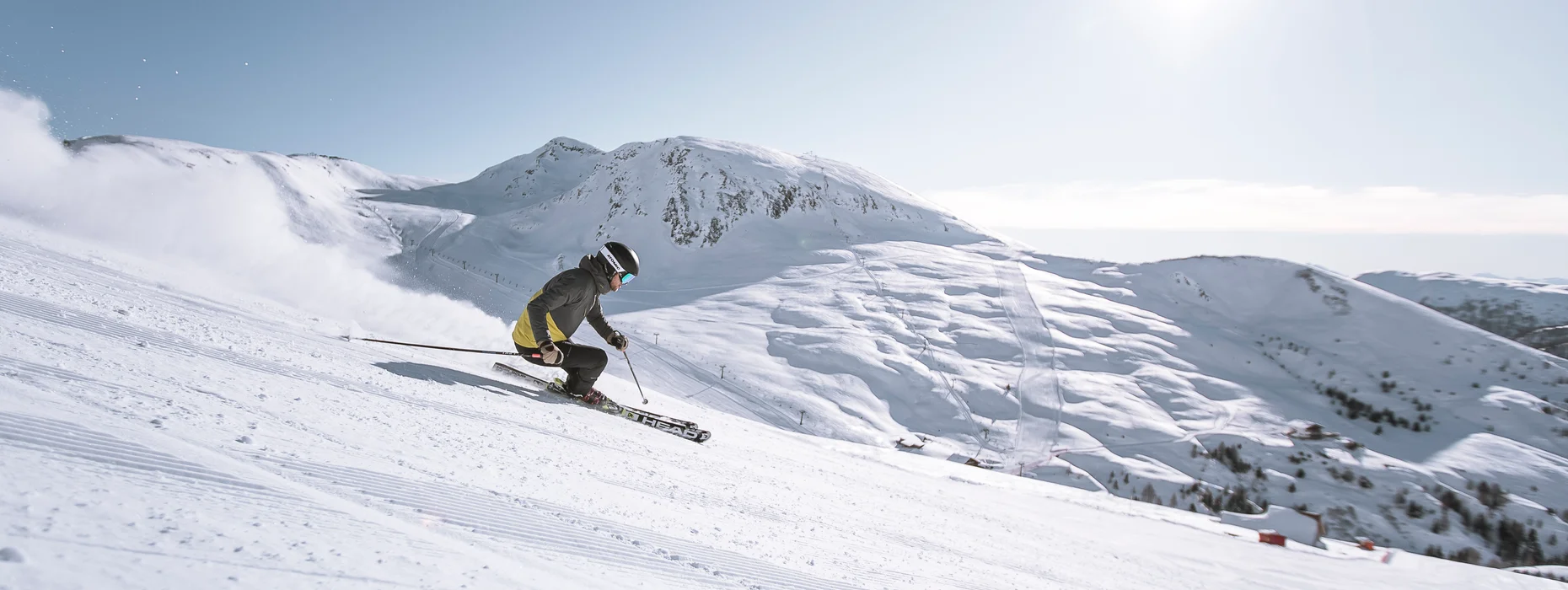
Ski &
Snowboard
WINTER-SUN PARADISE AND HEAVENLY SLOPES IN SOUTH TYROL
A clever network of ample, sprawling slopes right at the gates of the stunning city of Merano in South Tyrol: Merano 2000 is the perfect winter destination for families.
Bask in the sun, indulge in some serious skiing and explore the winter wonderlands of the Alps.
40
KILOMETRES OF SLOPES
FOR PURE SKIING BLISS
15
MOUNTAIN HUTS
TO SPOIL YOUR PALATE
07
MINUTES ON
SOUTH TYROL'S LARGEST ROPEWAY
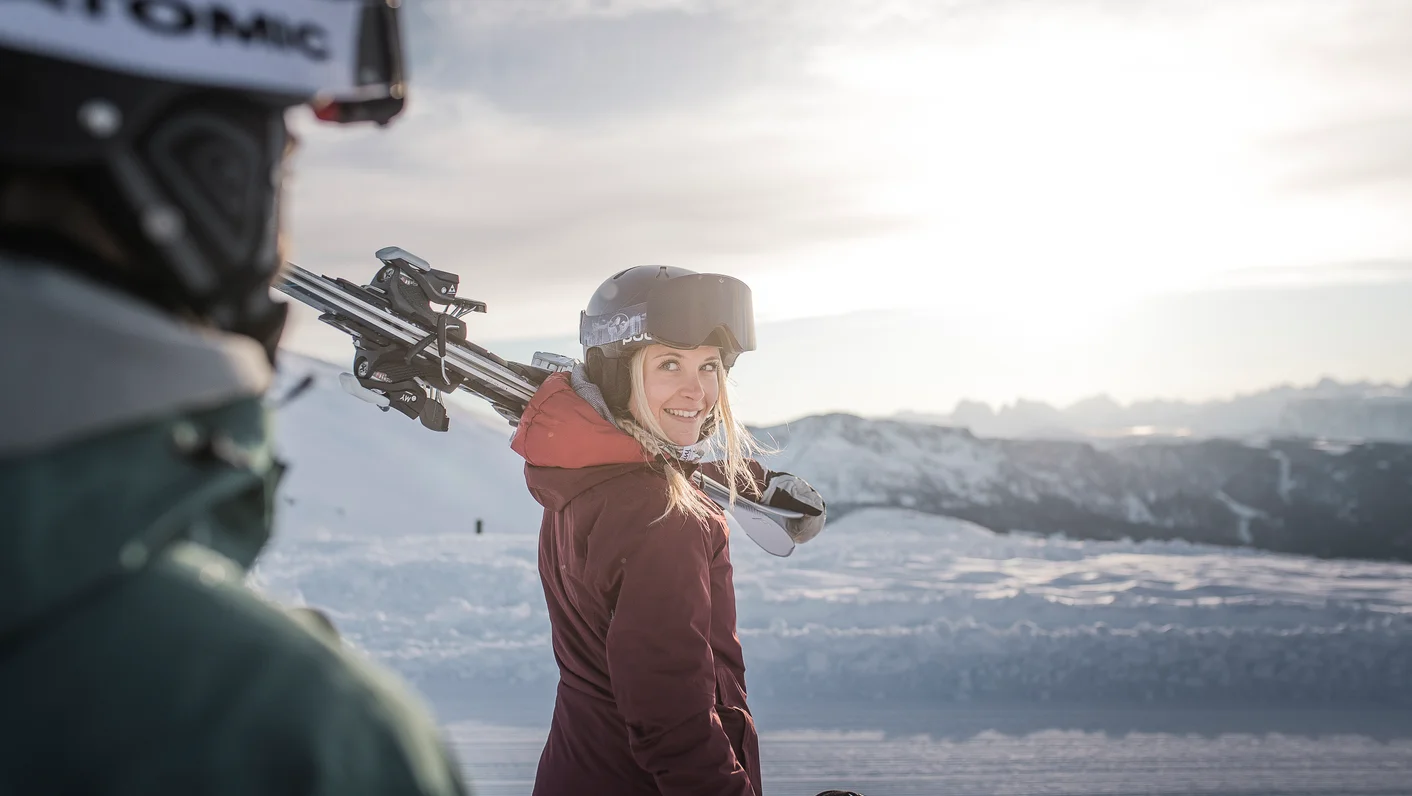
KIDS AREA & SNOWPARK
With around 40 km of ski runs in several degrees of difficulty, Merano 2000 meets the requirements of both seasoned skiers and families with children: guaranteed action and fun.
Just outside the mountain station at Pivigna, the KIDS AREA offers a fun and safe space for kids and beginners to get started on the snow with the help of our expert skiing instructors and the magic carpets at the ski kindergarten facility. The Kids Area is free of charge and open to everyone during lift operating hours.
Looking for more action and adrenaline? Then head to the SNOWPARK for some white-knuckle rides and tricks! And when you're over and out, join the shaper crew at the hangout, a much-deserved chill-out spot in the lower section of the snowpark.
Compulsory wearing of helmets
From november 1st EVERYONE must by law wear a helmet while skiing or snowboarding on South Tyrol’s slopes. Helmets for children must be certified complying with CE norms. The rentals ‘Rent & Go’ and ‘Sport Max’ offer suitable helmets for a fair price.
However, also adults should not feel comfortable to ski without an appropriate helmet.
Rules on the slopes
Safety standards for a carefree holiday at the ski resort of Meran 2000:
- Respect for other skiers: you are responsible for your own safety and that of other skiers and snow boarders. Be aware of people around you and take necessary action to avoid skiing dangerously or causing a hazard to yourself or others.
- Control of speed and manner of skiing: control your direction and speed of travel, taking account of the terrain, snow, weather and traffic conditions.
- Choice of path: select an appropriate path. If you are skiing behind someone it’s your responsibility to ski around them without causing any danger to them.
- Overtaking: you can over-take from either left or right but you must leave enough distance between yourself and other skiers to allow them to manoeuvre properly.
- Joining and starting: before starting off or pulling out you must look up and down the slope and choose an appropriate moment to execute your manoeuvre, so as not to endanger yourself or other skiers.
- Stopping: avoid stopping at blind corners or narrow or enclosed places unless you have to i.e. you’re injured. In the case of an injury you must vacate the spot as soon as practicable, to avoid further danger (to yourself or others). You should always stop at the side of the slope.
- Ascending and descending: you must always use the side of the slope to walk up or down, whether wearing skis or not.
- Observing the signs: pay attention to and follow the signs, markings and notices on the slope.
- Offering assistance: you are obliged by law to offer help and assistance in the event of any accident.
- Duty to identify yourself: you are also obliged by law to give your personal details in the event of an accident, whether you caused it, witnessed it or assisted at it.
- The access to the slopes is forbidden to hikers, ski mountaineers, tobogganists and with bikes. The uphill walking and the sledging down on the slopes are strictly prohibited.
- According to Art. 31, it is forbidden to skiing while intoxicated by consuming alcoholic beverages or toxicological substances.
Slopes closure: the slopes close 30 minutes after the last ride of the respective lift. The control service of the ski patrol is concluded after the closure. The entire ski area is closed after 18:00. The access to slopes and toboggan run ia prohibited after closure.
The operator of the ski area is not liable for accidents occurring away from the designated runs. The official FIS rules can be found here: www.fis-ski.com
112 - Provide first aid
In the unlikely event of an accident or if in need of assistance contact the ski patrol and emergency services by calling 112.
Anyone witnessing an accident is obliged to provide first aid:
- Secure the accident site: Place your skies into the snow forming a cross about five to ten meters above the accident scene. In case the injured person lies below a hill, place your skies on the top of the hill so that other skiers are alerted in time, can quickly identify the accident site and avoid the interested part of the slope.
- Clear the slope: After securing the accident site it might still be advisable to remove the injured person from the slope to the edge of the slope in order to prevent further collisions. However, if the accident victim shows clear signs of head, neck or back injuries, he or she must not be moved under any circumstance.
- Alert the ski patrol service: While on the slopes you should generally always have a mobile phone on you. Contact the emergency services to give indications about the location of the accident and to provide information on the victim as well as his or her injuries. EMERGENCY NUMBER 112
- Provide first aid: If you are the only person at the scene of the accident, securing the site has higher priority. However, if there are multiple persons at the site securing the site and alerting the emergency services can be done while someone is providing first aid to the injured person.
First of all check the vital signs. Should the accident victim not breathe, be unconscious or suffer a cardiac arrest immediately start performing resuscitation measures - cardiac massage and mouth-to-mouth resuscitation. Every minute counts.
If the injured person is unconscious but shows stable vital signs, turn them to the side into a stable lateral position and wait until rescue arrives. - Do not move: If the victim is addressable and has pain in the back, the neck or the head do not move him or her under any circumstance due to a potential spinal cord-injury. Check if the victim can move their fingers and toes and feel their hands and feet. If so you can exclude the possibility of a vertebral fracture and move the injured person to the edge of the slope.
- Keep from cooling down: In case of extremely cold temperatures and extended contact with snow the accident victim might suffer frostbites. You can spot them as the skin whitens and becomes insensitive to pain. You should therefore ensure that the injured person does not cool down and is kept warm at any time.
Avoid injuries
84% of all injuries related to skiing are self-inflicted and result from falling rather than collisions. Being well prepared therefore allows to significantly decrease the risk of an injury:
- Good physical condition is a prerequisite.
- Always check the weather conditions in advance.
- Approach the first days on the slopes slowly, so that your body can get used to the altitude as well as the physical demands.
- Overestimation of one’s abilities resulting in a riskier skiing style can easily lead to injuries. It is suggested to increase your speed gradually.
- Warming up before the first descends gets your circulation going and heats up your muscles reducing the risk of injuries on the slope.
- Make sure to get enough rests during your rides and do not forget to keep hydrated during the day - possibly water and no alcohol.
- Proper protection equipment is essential to prevent injuries: ski helmet, back protectors and wrist protectors (especially for snowboarders).
Even if skiing if accidents on the slopes can never be avoided at all, many injuries can be prevented by skiing carefully, a cautious attitude and proper protective equipment.
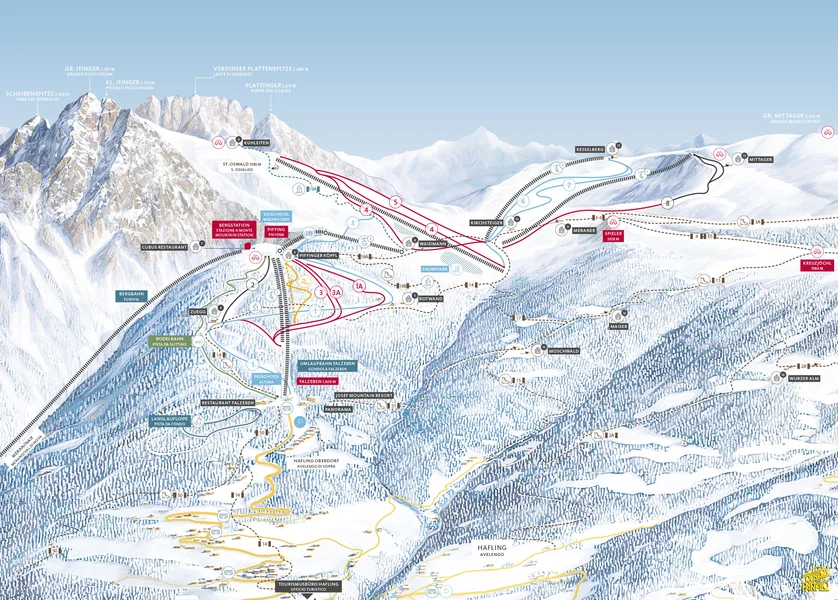
Overview of
Merano 2000
Slopes, lifts, toboggan runs, hiking trails, look-out points, alpine huts, inns and restaurants – discover Merano 2000 and find your ideal destination with our winter-time map.

